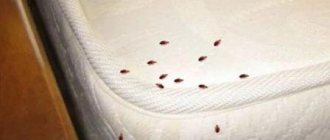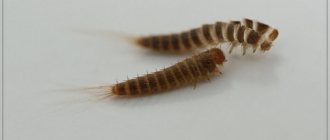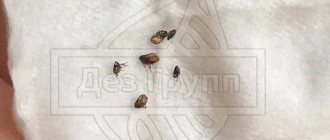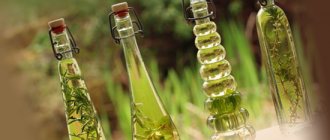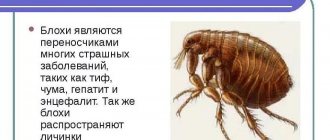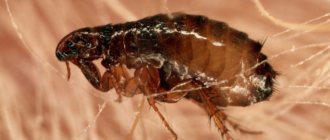Sand fleas - where they come from and why they are dangerous
The insects belong to the genus Tunga.
The second name is considered to be “earthen flea”. They are considered distant relatives of rat and cat parasites. The width of the body does not exceed 1 mm, and the length is 1-2 millimeters. The brown shell is very strong, so it is unlikely that you will be able to crush a flea with your fingernail. Parasites do not have wings, but are capable of reaching from 14 to 36 cm in a jump. Insect larvae resemble small worms. Habitat: grass, hut floors, trash cans. In addition to humans, domestic animals such as dogs and cats, as well as cattle such as sheep, horses and mules, become victims of pathogens. Attacks on monkeys, mice, elephants, and pigs are possible.
According to statistics, fleas most often attack those who do not wear shoes. Women suffer from bites less often than men. A surge in insect attacks is recorded in September. But in January you will hardly find parasites. By the way, these creatures of God bite people selectively. Out of 5-6 people located close to each other, they can attack only one.
Appearance
The question of what sand fleas look like worries every person who decides to go on a trip. The parasites are incredibly miniature, as their length does not exceed 1.5 millimeters. It is simply impossible to see them with the naked eye. The body of fleas is divided into the abdomen, head and sternum. Sand fleas also have three pairs of legs. Parasites jump long distances - up to 40 millimeters. The color of the sand flea is black or dark brown.
Since it is impossible to see parasites, they can be identified by their bites. Males rarely bite people, and female bites are considered the most painful. First, the insect gnaws through the skin, after which it gets under it, trying to find blood vessels. This causes acute pain and severe discomfort.
What sand fleas look like (photo)
Main differences from the harmless sand flea
Ordinary fleas live a completely peaceful life, suck blood and reproduce outside living creatures. And female African fleas are looking for living flesh to nest under the skin until the next oviposition period.
Attention! The sand flea cannot bite through the skin to completely penetrate; it releases a special liquid like acid that corrodes the upper layer of the epidermis.
Flea, but not that one
Fleas are a group of insects that have lost their wings, but have mastered long jumps using their back pair of legs. Most fleas live on mammals that have permanent burrows or in bird nests. Adults bite burrow/nest owners and drink their blood, while larvae find food in the litter. Modern man not only does not suffer from fleas, but, as a rule, has never seen them at all.
Sand flea, or Brazilian ground flea ( Tunga penetrans
, rice.
3), leads a free lifestyle, biting animals passing by, which is unpleasant, but tolerable. But the fertilized female T. penetrans
bites under the skin - after this, the female’s abdomen swells to the size of a pea, from which the eggs fall out as they mature. Itching, scratching, inflammation...
Rice. 3.
Flea
T. penetrans
before and after introduction, from the Brazilian site aneste.org
In the 19th century, the ground flea was brought from South America to Africa, where it immediately felt at home. In the 20th century it reached India. I have not found any reliable evidence of the presence of the ground flea in Southeast Asia. In any case, my friend, who is also a doctor by training, was bitten not by an earthen flea with obvious symptoms when it penetrated, but by someone invisible. Who?
Where do sand fleas live?
Parasites can be found in various tropical countries. However, the largest number of insects is concentrated in areas that belong to the Caribbean. These are Cuba, Trinidad, Dominican Republic, Africa. Beach fleas can be found even in unexpected places, where people do not expect to find them.
Sand fleas in Sri Lanka are larger in size. They often bite people because they live almost everywhere. It is difficult to avoid encounters with parasites, so try to avoid bare areas of the body.
In Thailand, such parasites have literally infested the country. Sometimes sea fleas in Thailand ruin your holiday, because it is incredibly difficult to avoid encountering them. There are also many of them in India, because there is a suitable environment for their reproduction. There are sand fleas in Vietnam, but they do not cause much discomfort to tourists. Fleas are concentrated in rural villages, as well as in polluted cities, where there are suitable conditions for their reproduction.
There are sand fleas in Cuba , which affect the local population. They become active when the weather is hot. At such times, it is very difficult to walk through areas with dense vegetation or relax on the beach without encountering insects. Local residents have long learned to deal with problems with the help of properly selected clothing and sprays, which tourists also need to do.
The question, where do sand fleas live , does not have a clear answer. They live under stones, in the floorboards of private houses, on beaches in the sand. Insects parasitize goats, dogs, cats and rats, as well as other animals. It is very easy for them to find a victim for themselves, which will become their main source of food. Any African flea or parasite found in another region can migrate to your clothing.
Reproduction
The process of insect copulation can last several hours. Females have a uterus and ovaries. Males have a sexual organ called the sex claw. During mating, the female is on the back of the male and draws the sperm into herself. It takes about 15-20 minutes for the genetic makeup to reach the uterus.
The only condition for successful conception is access to food. For this reason, on the eve of intercourse, the female feeds on the blood of the owner so that she has enough strength to mate. Immediately after the process, the individual also eats; food gives it energy and accelerates the process of egg maturation. If conditions are favorable, a flea can lay several groups of larvae per day. More often it is removed from the wound before birth.
Pest development cycle
The development cycle of the parasite has 4 stages:
- egg;
- larva;
- chrysalis;
- adult.
2 days after conception, the female is ready to lay eggs. Most often, insects do this on the body of an animal, less often on a person. A flea can lay from 30 to 50 eggs per day in batches of several pieces. Along with the eggs, the female lays out a certain amount of feces - digested blood, which has a brown color.
After a few days, the eggs hatch into larvae.
The most important condition for the existence of the organism at this stage is moisture.
Outside the host organism, the larva penetrates the sand and feeds on organic debris. On the body of an animal or person, the larva absorbs the remains of feces.
The body grows within a week. During this period, the larva molts using the fibers of its scales, wraps itself in a cocoon - a pupa appears. The cocoon is wet, sticky and within 7 days it grows an adult inside it.
The life cycle of an insect lasts about 15 days. The pupa may not develop into an adult in the absence of appropriate conditions and may prolong the cycle up to 12 months.
Places of distribution
The sand parasite is often called the earth flea. The reason for this is its habitat.
It can live in dry sand on beaches, in dirt floors in houses and outbuildings, in garbage, in tall grass, in soil near puddles and ponds. Insects hatch their offspring in dust or litter.
Parasites are found in many countries:
- Caribbean - Cuba, Dominican Republic, Jamaica;
- Africa – Trinidad, Congo, Dominican Republic;
- South Asian countries - India, Laos, Myanmar, Thailand, Vietnam;
- Central America - Uruguay, Brazil, Mexico.
More often, insects live in places where the land is not treated to remove parasites. Well-known resort beaches and city areas intended for tourists do not allow the spread of parasites. But in the territories of the towns of Nha Trang or Sanya, in the forests of Thailand, there are cases when sand fleas have bitten people.
Fleas can live in dry sand on beaches
Where do sand fleas live and how do they bite?
The habitat of such insects is not far from human habitation, near water and farmland. They wait on the leaves of small bushes and grass, in the sand on the beach, in the ground near creeks.
Infection occurs when a tourist walks barefoot on beach sand, squats, or walks through thickets near water. The parasite affects the feet, legs, groin area and back. Often he chooses a place under the nail. There are many capillaries for easy obtaining of food.
Note. You should not visit wild beaches at the resort, especially in September. Sand fleas are especially active this season. Beaches are not disinfected by sifting sand.
The sand flea is very small in size and almost impossible to see. The bite is not felt; its location can only be discovered after a few hours.
What do sand fleas look like?
Fleas are similar to other insects, so it is easy to confuse them with other types of parasites. Unfortunately, various parasites live in many warm countries, so it is impossible to exclude contact with them. A person who encounters such insects risks contracting a dangerous disease. So, with whom are these parasites most often confused:
- Mosquitoes. Mosquitoes are very fast, so it is very difficult to notice them. They land on the body and instantly fly away. However, their bites are very similar to fleas.
- Ants. They only bite if you accidentally crush them.
- Ticks. Such parasites drink blood for a long time, but a person may not feel pain. After the tick eats its fill and falls off, bumps appear at the site of the bite, which itch and hurt.
- Bedbugs. Such parasites are found only in poorly equipped hotels. Insects can bite a person, but this does not cause bumps on the body.
Now you know what sand fleas are , how to distinguish their bites and cope with the consequences of the problem. Be sure to take responsibility for your own safety while traveling. Otherwise, you will encounter dangerous diseases that can cause negative consequences.
Sand flea bites
The pain and severity of sand flea bites are similar to those of regular mosquitoes. When bitten, you may feel a slight itch and notice slight redness. Human skin is very elastic, and the size of the bite hole is so small that it cannot be seen. You can only feel a slight swelling in this place.
A person does not pay attention to such symptoms, mistakenly believing that he was bitten by some other insect. This is the main cunning of the sand flea. After a few days, the health condition begins to deteriorate sharply, and the symptoms become more severe. Most people are unaware that a parasite develops under the skin, and scratching it only increases the infection. The combination of these factors leads to the fact that a person begins to treat the symptoms on his own, without understanding the main cause of itching and redness.
Rules of conduct in tropical countries if you are planning to go there on vacation:
Try to wear shoes on the beach . This way you will protect your feet, which are the most vulnerable places;
Sunbathe on some kind of mat, but not on open sand . The best option for this are special sun loungers. When resting on them, you will be at a certain distance from the sand, which significantly reduces the risk of infection;
Get vaccinated . Having penetrated the skin, which contains toxic substances, the flea is unlikely to want to stay there. If you are planning a trip to southern countries long before your vacation, vaccination will become a reliable protection. You may have to take a course consisting of several injections during a certain period between them. Be sure to consult your doctor, do not vaccinate yourself!
Choose modern hotels . In such hotels, specialists are aware of this danger, so they do everything possible to prevent guests from becoming infected with a dangerous parasite. Usually hotels have a qualified doctor who can provide first aid.
Precautionary measures do not provide a 100% guarantee that you will not catch a sand flea. But the likelihood of infection with this parasite is significantly reduced!
Routes of infection by sand fleas
A sand flea bite is not only unpleasant, but also very dangerous. You may encounter tungiasis, which is a serious disease in the field of dermatology. If a flea bites a person, he feels severe itching and pain that burns the affected area of the body. Jumping parasites primarily affect the legs and feet. Much less often, parasites bite hands and other parts of the body.
In the place to which the flea has attached, a small purulent abscess appears. There is a dark dot in its center. The arthropod is inhabited by pathogens of dangerous diseases, so you cannot extract it yourself. If the parasite disintegrates, then its particles will remain inside the tissues, which will lead to all sorts of complications.
Even the smallest sand flea is a time bomb. Such parasites are considered the main cause of troubles while traveling. You need to take good care of your body parts to avoid facing problems.
Preparations for the treatment of sand flea bites
Some of the obvious symptoms indicating a bite are tumors and unbearable scabies. Before applying medicinal products, the wound must be disinfected. Hydrogen peroxide is suitable for these purposes. After this procedure, you can use medications to help get rid of discomfort. They come in three forms:
- cream;
- repellent spray;
- pills.
Each remedy is effective at different stages, depending on the scale of the disaster and the size of the bite.
The most popular antihistamine creams are:
- yellow balm;
- Phenergan cream;
- Fenistil;
- Compound Dexamethasone Acetate Cream.
They perfectly relieve itching and pain, after which the desire to scratch the body disappears, in addition, they are suitable for children. To eliminate scabies and inflammation, you can also use hormonal agents based on hydrocortisone or sulfur ointment. Preparations containing Aloe Vera will have a calming effect.
Of the repellent sprays, Mentholatum Remos is the most effective.
Its action lasts up to 6 hours. In addition, it is suitable for children aged 4 years and older. You can also use Calamine lotion. This antiseptic speeds up the healing process.
Tablets are divided into antihistamines and antibiotics. Among antihistamines, cetirizine hydrochloride 10 mg (Cetirizine Hydrochloride) is effective. Suprastin and Zyrtec have less effect. These medications reduce scabies, but are contraindicated in children under 7 years of age.
Antibiotics reduce the affected area and itching, but act more slowly than creams. For example, when taking Hapenxin XX 500mg in capsules, changes become noticeable only after 5-7 days, and complete recovery occurs after 7-8 weeks. As a rule, both types of tablets are used in combination. The downside is that medications can cause drowsiness.
Traditional methods of getting rid of the consequences of bites
In addition to medications, there are effective folk remedies that can eliminate itching after a bite. Their essence boils down to the effect of high temperatures on the affected area.
- If you direct a hot stream from a hairdryer to the bite site, you may feel relief. True, you need to blow carefully. Otherwise, you may get burned.
- Instead of a hairdryer, you can use hot cutlery - knives, spoons or forks. The device is placed in boiling water for a couple of seconds, and then applied to the affected area.
- Another alternative is a hot shower. You need to turn up the temperature, which is almost unbearable to endure. Of course, the skin will turn red, but after it is dried and moisturized with cream, the itching will go away.
Symptoms of a sand flea bite
Sand fleas are not the only danger facing travelers. Tropical countries are filled with other parasites that are partial to human blood. However, the signs of a sand flea bite cannot be confused with other phenomena. They appear in the following moments:
- severe pain occurs;
- the bite site swells and becomes red;
- severe itching is felt;
- the bite site swells;
- tissues that are affected become black;
- small white larvae can be seen.
If you see that the insect's abdomen is sticking out from under the skin, there is no need to try to get it out. The parasite is fixed under the skin with the help of tenacious legs. If you fail to remove the flea, it will die, so the inflammation will worsen. Sand fleas in Thailand are incredibly dangerous, so you need to protect yourself from such an unpleasant encounter.
Why are sand flea bites dangerous?
Speaking about the consequences of a bite, it is important to understand whether all sand fleas - both males and females - are equally harmful. If the victim is bitten by a male, the itching will not be intense. There is no need to fight it; it will go away on its own in a few days.
But if a tourist is attacked by a fertilized female, she will definitely need blood. This is the main danger. The fact is that the sand flea does not just bite, but gnaws into the epidermis. Most often, she chooses the skin under the nails and between the fingers. Then, due to special enzymes that dissolve the layers of the epithelium, it penetrates even deeper and is absorbed into the blood vessels for further replenishment. There the flea swells to the size of a small tangible ball, and several hundred eggs mature in it. The affected area becomes inflamed and ulcers appear. After some time, the insect injects eggs from the wound and then dies.
As a result, the parasitic tropical disease sarcopsillosis may occur. It is also called tungiasis, because, as mentioned above, sand fleas come from the genus Tunga. Complications of the disease are fraught with abscesses and even death.
In addition, insects can cause terrible pathologies:
- sepsis;
- lymphostasis;
- lymphangitis;
- pneumonia;
- loss of nails;
- tissue necrosis;
- thrombophlebitis;
- ulceration to the very bones;
- deformation and even loss of fingers.
The pain from the female's bite is so severe that the victim, whose feet and legs are affected, has difficulty moving.
Prevention from sand flea bites
There are a number of ways to avoid encounters with sand fleas:
- Avoid visiting the beach at sunrise and sunset. An early morning boat trip along the edge of the coast is romantic. But it is precisely at this time that the parasites reach their highest activity.
- Apply repellent creams and oils to your skin after each swim. It is important that the repellent is local, it is more effective.
- Wear socks and shoes, and refrain from touching your naked body to the ground.
- Maintain cleanliness in the home.
- Wash your feet in warm water after walking.
- Avoid shady places on the beach.
In addition, before traveling to an exotic country you need to get vaccinated. Some tourists advise not to lie on the sand at all, but to sunbathe exclusively on a sun lounger. But it is worth considering that fleas can jump high.
How to recognize an insect bite
A tourist who is bitten by a sand flea may not suspect anything for at least several more hours. The maximum incubation period reaches 12 days.
The moment of the bite itself is not felt in any way, and the size of the insect, as mentioned above, does not exceed a few millimeters, so it is difficult to notice the flea. They live on dry and wet sandy beaches. It doesn’t matter whether the place is deserted or crowded - insects will always find a victim.
How to recognize a sand flea bite?
- The skin begins to itch.
- Most often the extremities itch – legs, especially feet, and arms. Damage to the body - neck, back, abdomen, groin - is possible. The genitals, lips, and back of the head may be affected.
- Over time, the itching becomes more intense, and bite marks become obvious. They are larger in size than mosquitoes, and the affected area swells up like a lump. A clear point is clearly visible in the center - the body of the insect.
- If the degree of attack is low, then there are no more than 5 lesions, and with the maximum form - over 30.
- Severe forms of infestation are more common among people of retirement age.
Those who are not particularly knowledgeable can easily confuse a flea bite with the way a bug bites. But the difference is that after the bite of the latter there are no cones left, and they mainly affect the legs.
Harmless amphipod
Let's start with the “enemy”. He is “neither a friend nor an enemy, but so,” he is a crustacean, an amphipod ( Amphipoda
,
Talitridae
). Among the representatives of this order there are species that do not live in water, like most crustaceans, but in the surf zone on wet sand, where they feed on algae washed ashore. Why is a harmless vegetarian slandered on the Internet? The fact is that amphipods are the favorite food of sandpipers. Many people have probably seen sandpipers on the shores of cold and warm seas. A flock of them moves along the shore in a sinusoid, running away from incoming waves and catching up with outgoing ones (Fig. 2). From such a life, amphipods learned to jump, sharply unbending their abdomen, which was tucked under the body. Amphipods are poorly able to regulate the direction of a jump, but, apparently, the jump already complicates the hunting of sandpipers. For these jumps, the amphipods of the surf zone of the northeastern Atlantic received the name sand fleas, and their relatives on warm beaches also began to be called “sand fleas.”
Rice. 2.
A flock of sandpipers hunts amphipods. Photo by Grigory Smekalov (Sakhalin)
The English language is not rich in word-formation tools: starfish - starfish, jellyfish - jellyfish. The name sand flea is used twice - for surf amphipods and for a really nasty flea, which we will move on to after rehabilitating the amphipods.
Treatment
It consists of antiseptic treatment, relieving swelling and itching. If the female has laid eggs in the wound, you should immediately consult a doctor. Carrying out removal procedures on your own is dangerous - the consequences can be very serious.
Treatments:
- Painkillers, cooling ointments and sprays.
- Antihistamine ointments or tablets.
- Antiseptics.
To treat contaminated premises, special disinfectants are sold in the form of sprays, ampoules and solutions. All treatment and protection products are sold in local stores and pharmacies.
Unfortunately, there is no vaccination to help prevent the consequences of sand flea bites.
How to prevent bites
You can reduce the risk of flea bites to a minimum. To do this, while in dangerous areas, you must follow the safety rules:
- always wear socks and shoes;
- do not walk on the beach without beach slippers;
- do not sit on the sand;
- wash your feet daily.
When traveling to an exotic country, get the necessary vaccinations and buy the necessary ointments or other means to protect against insects
A sand flea bite is an unpleasant incident. To prevent sad consequences, you must immediately seek medical help and remove the parasite. Then you can be sure that everything will end well.
Health care
If you are bitten by sand fleas, it is better to be treated immediately to prevent further complications. Bloodsuckers often become carriers of other serious infections, so emergency treatment of the bite site and taking medications that support the body are encouraged. It would be a good idea to contact your local doctor for advice.
Treatment for sand flea bites depends on the severity of symptoms:
- to relieve itching and redness in the event of an attack by males, use antihistamine and anesthetic creams applied to the affected areas;
- frequent scratching of blisters leads to the formation of wounds and ulcers, which quickly become infected, so they use disinfectants, apply sterile dressings, and take weak antibiotics.
Female bites require a professional approach. Sand fleas under the skin can withstand an incubation period of several hours to 12 days. During this time, the symptoms become obvious: severe pain appears, the temperature often rises, an abscess and yellowish fluid are visible. Treatment requires specialist surgery to cut the skin and remove the female's swollen body, which is full of unborn larvae. Independent attempts to get rid of the insect under the skin with needles, removal with a knife or ordinary squeezing threaten to break through the abdomen of the parasite and infect the human circulatory system with its contents.
It is necessary to immediately treat the bite site to avoid complications
Signs of infection and how to get rid of it
Bites from fertilized fleas cause the invasive disease sarcopsillosis (tungiasis). After being bitten by a female that has begun to reproduce, a person feels itching and observes redness in this area with a black dot in the middle. Over time, a white spot appears around the point, and the itching and burning intensify. Such signs cannot be ignored: this is not an abscess, but an endoparasite that has bitten into the skin. If you become infected with tungiasis, you should consult a doctor as soon as possible.
Important!
Treatment for sarcopsillosis is carried out only under the supervision of a doctor.
Only a doctor can tell you how to treat a sand flea bite. For treatment, a specialist prescribes an antibiotic, since a secondary infection that has settled on the affected area can even lead to gangrene.
The local population picks out queens with a needle, but this should not be done. Self-medication with a needle often leads to complications due to pieces of endoparasite remaining in the skin. You can see the result in the photo of the affected leg.
Brazilian ground flea under the skin
Ways to get rid of sand fleas
There are quite a few means to get rid of sand parasites, and it is important to remember that an insect can develop immunity to the same method (except in cold temperatures), so it is important to try to diversify each procedure.
Chemical means for control
Among the chemicals, the following are considered the most popular and effective:
- Tick Carpet Spray - will help get rid of parasites on fleecy surfaces (carpets, curtains, etc.). After using the product, you must thoroughly vacuum the surfaces and wet clean the house. Tick Carpet Spray
- TRoom Fogger - used to destroy larvae. The product can be used in both non-residential and residential buildings. The treated room is closed for 2 hours, then allowed to ventilate for about 20 minutes. Wet cleaning is also required. TRoom Fogger flea spray
A person can protect himself from fleas with the help of various sprays and repellents used against ticks, mosquitoes, etc.
Traditional methods
Traditional methods are considered not very effective in fighting insects, but for prevention or as an addition to chemical agents they are used quite often:
- Hanging wormwood in all corners of the house or room where parasites live.
- Provide frequent ventilation, as the insect cannot tolerate low temperatures.
- Also take fabric items and bedding out into the cold and keep them there for several hours. Afterwards treat with a mixture made from salt and soda, then vacuum everything thoroughly.
- It is better to wash the room with a solution made from tansy and nettle.
- Place pine shavings in inaccessible places.
Sand flea remedy
The most popular and effective insecticidal preparations, with which you can efficiently fight and get rid of dangerous insects, are the following:
- Gett (Master 250, Empire 20);
- Raptor (harmless spray with an unobtrusive odor);
- Chlorpimirac (after a couple of hours, this product must be removed from the furniture, otherwise streaks may remain).
How to poison sand fleas in a production facility - means
Inside large production facilities, in order to poison sand parasites, it is still more advisable to use the help of real specialists. Call a pest control service. Even though this is not an entirely economical option, in this situation the speed of removal of individuals and efficiency are important.
The most common method of treating premises, which allows us to adequately fight ectoparasites, is thermal aerosol. It is carried out using modern microencapsulated preparations, which are harmful to insects, but safe for people, which is very important. Among them are:
- Extermin F;
- Fendon;
- Effective Ultra;
- Minap 22;
- Sinuzan;
- Biorin.
Through fog (droplets of 0.05-0.5 microns), the insecticide is able to penetrate into the most remote and inaccessible corners (plinths, cracks, drains). After using this method, your clothes and furniture do not require special care, they are clean and streak-free.
How to get rid of sand fleas
If fleas appear at home, you need to get rid of them urgently.
How to poison sand fleas in a production facility, means
Disinfection is carried out in the production premises itself and in the area surrounding it. The product is sprayed everywhere, paying special attention to the floor, cracks and wooden structures.
You can choose from:
- Tick Lawn Spray. This is a specially developed drug for non-residential premises and open areas. Toxic and hazardous to health, but effective drug. When spraying, wear protective clothing and a mask.
- TRoom Fogger. Designed to destroy larvae. Can be used in non-residential premises and at home.
Procedure for using funds:
- after spraying the product, close the room for 2 hours;
- open and ventilate for 15-20 minutes;
- carry out general cleaning with kerosene diluted in water in a ratio of 1:3.
After some time, disinfect the room again.
How to get rid of sand fleas in a private home using folk remedies
Folk remedies are not very effective against the parasite. As a preventative measure and for poisoning remaining sand fleas, you should adhere to the following rules:
- hang bunches of wormwood in all corners of the room;
- arrange long ventilation. Fleas do not like the cold and die at low temperatures;
- take all fabric bedding, carpets, blankets, pillows and curtains out into the cold and leave for several hours;
- then treat with a mixture of baking soda and salt. Vacuum thoroughly;
- Wash the room completely with a solution of tansy and wormwood;
- Leave pine shavings in corners and inaccessible places.
Sand flea remedy
This type of flea is very rare in apartments. Sometimes it can settle on the territory of the Crimean Peninsula.
To etch it you need to purchase Tick Carpet Spray. The product destroys parasites on fleecy surfaces: carpets, bedspreads, curtains.
After treatment, thoroughly vacuum everything and do a wet cleaning.
What does a sand flea look like?
This flea genus is a distant relative of the well-known cat and rat species. The length of their body is only about 1-2 mm, the color is dark brown.
They have a very strong shell, making it extremely difficult to crush an insect. Despite their tiny size, they are capable of jumping to a height of more than 35 cm. Increased activity occurs in the evening and at night, which is when the bloodsuckers begin to attack.
Females are especially dangerous; they penetrate the skin and lay their eggs there, which leads to a terrible infection. You can only get rid of them surgically. Remember that the removal of subcutaneous larvae should only be carried out by specialists.
How to get rid of sand fleas
How to get rid of sand fleas in the house? The fight against them in a private house or apartment involves the same methods that are used to destroy common earthen parasites that come from the streets and basements. They include a number of consistent rules:
- Removing insects from your pets. During disinfestation, it is better to move pets to a safe place.
- Carpet cleaning (you can use laundry or dry cleaning services).
- Carrying out wet cleaning. All food products must be hidden in the refrigerator.
- Treating the home with insecticidal preparations or using folk recipes.
- Upon completion of the process, the room should be left for a while, then thoroughly ventilated.
To avoid relapse and re-infection, it is recommended to keep the premises clean, as well as repeated treatment aimed at removing previously laid flea eggs. In a couple of weeks they will give birth to new offspring, so they need to be destroyed in a timely manner.
Possible complications of lesions
In addition to painful sensations and local skin reactions to an insect bite, the development of complications is possible. We are talking about carriers of dangerous pathologies, for example, sarcopsillosis - extensive inflammation that causes severe pain and itching. Then the infection penetrates deep into the tissue and leads to tissue degeneration (necrosis).
In the absence of proper therapy, the development of an infectious process throughout the entire organism cannot be ruled out.
In addition, there are bites of sand fleas, which lead to a number of the following complications:
- deformation changes in fingers and nails;
- pneumonia;
- thrombophlebitis;
- psoriasis, finger amputation;
- elephantiasis.
Attention! Pests are capable of biting not only your legs. They also bite domestic animals. When fleas reproduce, they move from dogs or cats to humans and vice versa.
Possible consequences of a bite
In addition to pain and other unpleasant symptoms from a bite, serious complications are possible. Sand fleas are carriers of dangerous diseases , such as sarcopsillosis . In this case, intense inflammatory processes occur, causing acute pain and itching. The infection then spreads to surrounding tissues and causes degenerative processes (necrosis). If left untreated, the infection may spread throughout the body and sepsis .
In addition, bite can cause:
- deformation of fingers and nails;
- pneumonia;
- thrombophlebitis;
- psoriasis;
- finger amputation;
- elephantiasis;
- necrosis of affected skin areas.
Important. Parasites can settle on domestic animals (dogs, cats, pigs, etc.). The symptoms are similar to those in humans. Moreover, parasites are capable of multiplying and moving from animals to humans.
How dangerous is it and what consequences can occur after a bite?
If a male is bitten, the victim may experience a severe allergy, which can progress to asthma and sometimes anaphylactic shock. The bite site will be very itchy for 3 days.
If you constantly scratch the bite, you can spread the infection yourself.
If a female bites, an ulcer immediately forms on the spot, which will cause an inflammatory process and develop into tungiasis (a tropical parasitic disease that forms a large inflammatory infiltrate at the site of the bite or parasite penetration). If treatment is not started in time, a person may lose an arm or leg.
The following dangerous diseases can also be identified, the causative agents of which can be sand parasites:
- pneumonia;
- lymphostasis;
- elephantiasis;
- gangrene;
- tetanus;
- sepsis and much more. Sand flea bite
The list of diseases is quite frightening and dangerous, so it is important to follow several recommendations that will help you avoid encounters with insects:
- sunbathe only on sunbeds and mats;
- avoid unkempt and dirty beaches;
- wear slippers on the beach and any walks;
- use all kinds of body products;
- in areas with dense vegetation, wear only closed clothing;
- do not step on puddles;
- Conduct a thorough examination of the body every evening.
The many faces of sandfly
It’s worth changing the sand flea a little to sandfly - and the solution will come closer.
In non-American English, sandfly is translated as "mosquito" (family Phlebotomidae
).
Mosquitoes should not be confused with the mosquitoes that pester us in the forest (family Culicidae
); Few people have seen mosquitoes, like fleas; they live in arid regions, for example in Central Asia (and therefore the name sandfly in relation to them is quite justified). If someone still wants to get acquainted with mosquitoes in person, then I can recommend Turkey as a resort area, where they are present, albeit only a little, on the vast sand dunes around the ruins of ancient Side. To a non-specialist, mosquitoes look like ordinary blood-sucking mosquitoes, only clearly small. However, during the day they sit in shelters, most often in rodent burrows, and fly to bite at night. That's why it wasn't mosquitoes that bit my friend on the beach on Koh Chang.
In American English sandfly means or horsefly ( Tabanidae
), or the smallest mosquitoes from the family
Ceratopogonidae
, which in Russian are called “mokretsy”. (I can’t even imagine why horseflies and biting midges are called “sand flies”: horseflies have nothing to do with sand; midges are not only not sand flies, but not even flies, but mosquitoes. For clarification, please contact the Americans.) Horseflies in Thailand there are, but even cows and horses, when they are bitten by a horsefly, notice it well and react adequately. It was clearly not them who offended my friend. But biting midges are the correct answer. These small (usually 1.0–1.5 mm) creatures (Fig. 4) have earned their own word in the Russian language for a reason.
Rice. 4.
Female
Culicoides
bites a human (photo from diptera.info)
Precautionary measures
In order not to think about how to get rid of sand fleas, it is better to prevent this. Simple rules will help minimize the risk or avoid infection altogether:
- After arriving in a place where there are fleas, immediately begin using sand flea protection. There are repellents and sunscreens with a repulsive odor that you can buy everywhere.
- You can protect yourself from sand flea bites by wearing shoes on the beach and sunbathing on sunbeds.
- Do not visit places where the likelihood of infection is high: wild beaches, local settlements, poor areas and places where stray animals gather.
How to get rid of sand fleas in a private home using folk remedies
These parasites have a very negative attitude towards strong odors, and with their help you can effectively fight uninvited guests. Sensing something is wrong, fleas run away in search of new habitats. Among the folk recipes that came from our ancestors, the following are used to scare away little vampires:
Herbs (tansy, wormwood, geranium, cloves, lavender, mint). Bouquets of herbs, as well as individual branches of plants, can be placed inside the house or apartment in favorite places where parasites are concentrated. It is recommended to treat furniture, cabinet shelves with a decoction and tincture of herbs, and spray it on the walls. Wet cleaning with the addition of odorous agents to the water (vinegar, kerosene, gasoline, denatured alcohol, turpentine).
Wormwood oil can be poured into small containers and placed on the floor closer to the expected places where insects accumulate.
Where do sand fleas live?
Sand fleas in Vietnam are not particularly surprising to locals. Sri Lanka, Dominica, and Thailand are also rich in these individuals. They mainly inhabit the coastal areas of local beaches and love to live near water.
Insects are a great danger and it is almost impossible to protect yourself from them. Their main difference from other brethren is the ability to bite under the skin, which subsequently leads to the development of sarcopsillosis.
If you decide to use a remedy for sand fleas in Vietnam yourself, you should know that any of them is effective only until the parasite penetrates the skin.
Treatment for sand fleas
Sand fleas under the skin form peculiar swellings in the affected areas. However, sometimes this may simply look like a reaction to a bite. In any case, there is no need to take risks; urgent consultation with a doctor is required.
When you are convinced that the bloodsucker from Vietnam has not penetrated the skin, you can use the following treatment:
- Itching can be relieved with a simple cream with an anesthetic effect, for example, Yellow Balm.
- The issue of swelling after a bite can be solved by using Fenistil or Compound Dexamethasone Acetate Cream.
- Antihistamines help eliminate allergic manifestations and rashes.
